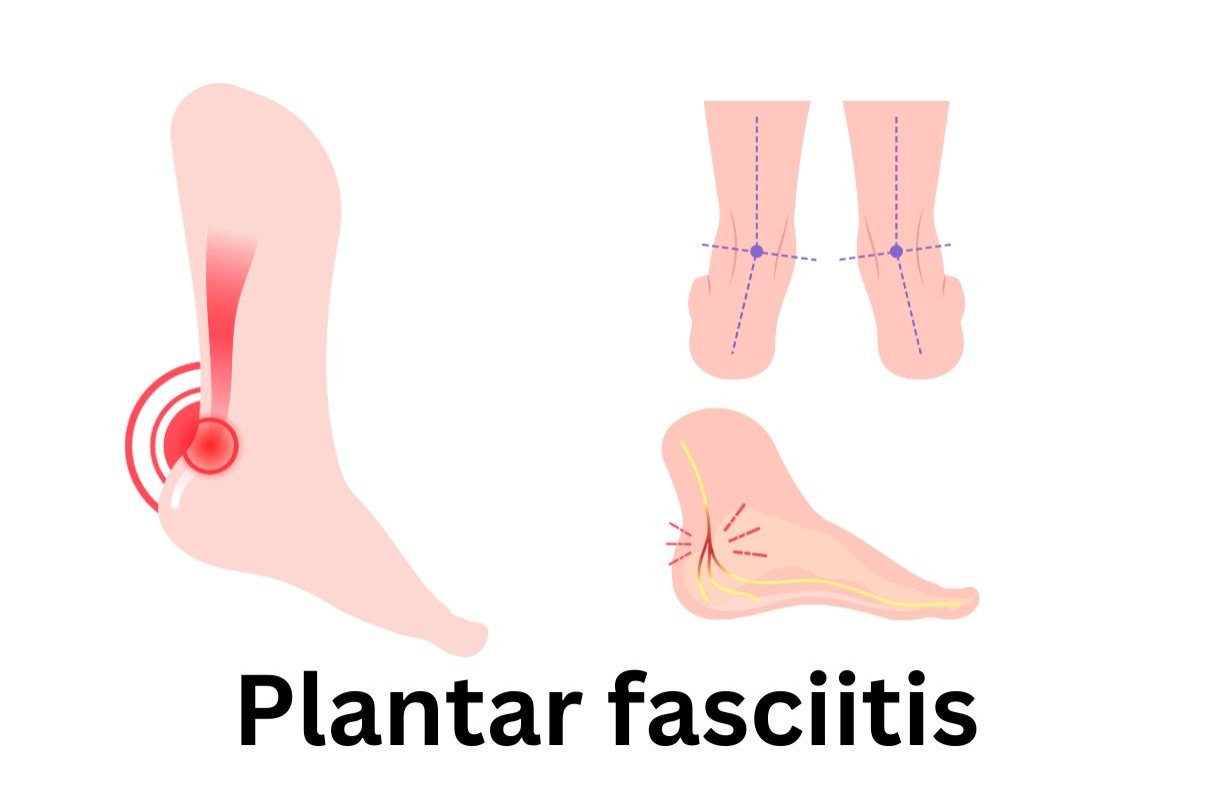Plantar Fasciitis: The Complete Guide to Symptoms, Causes, Treatments, and Prevention

Plantar Fasciitis: What You Need to Know
Plantar fasciitis is a common condition that causes pain in the bottom of the foot. It is caused by inflammation of the plantar fascia, a thick band of tissue that runs along the bottom of the foot. Plantar fasciitis is often worse in the morning, when you first get out of bed.
There are a number of things that can contribute to plantar fasciitis, including:
- Overuse: Plantar fasciitis is often caused by repetitive strain on the plantar fascia, such as running or walking on hard surfaces.
- Improper footwear: Wearing shoes that do not provide enough arch support can put stress on the plantar fascia and lead to inflammation.
- Tight calf muscles: Tight calf muscles can pull on the plantar fascia and cause pain.
- Weight gain: Excess weight can put stress on the plantar fascia and increase your risk of developing plantar fasciitis.
The symptoms of plantar fasciitis include:
- Heel pain: The most common symptom of plantar fasciitis is pain in the heel, especially when you first get out of bed in the morning.
- Swelling: The area around the heel may be swollen.
- Tenderness: The heel may be tender to the touch.
- Pain when walking: The pain may be worse when you walk for long periods of time or on hard surfaces.
If you are experiencing the symptoms of plantar fasciitis, there are a number of things you can do to relieve the pain and inflammation. These include:
- Rest: Resting the foot can help to reduce inflammation and pain.
- Ice: Applying ice to the heel for 20 minutes at a time can help to reduce inflammation and pain.
- Stretching: Stretching the calf muscles can help to relieve tension on the plantar fascia.
- Shoes: Wearing shoes that provide good arch support can help to reduce stress on the plantar fascia.
- Orthotics: Orthotics are custom-made inserts that can help to support the arch of the foot and reduce stress on the plantar fascia.
- Physical therapy: Physical therapy can help to strengthen the muscles in the foot and ankle and improve flexibility.
In most cases, plantar fasciitis can be treated with conservative measures. However, if the pain is severe or does not respond to conservative treatment, surgery may be an option.
If you are experiencing the symptoms of plantar fasciitis, it is important to see a doctor to get a diagnosis and discuss treatment options. With proper treatment, most people with plantar fasciitis can find relief from the pain and get back to their normal activities.
Here are some additional tips to help prevent plantar fasciitis:
- Warm up before exercise: Warming up the foot and ankle before exercise can help to prevent injury.
- Cool down after exercise: Cooling down after exercise can also help to prevent injury.
- Wear supportive shoes: Wearing supportive shoes that provide good arch support can help to prevent plantar fasciitis.
- Stretch regularly: Stretching the calf muscles regularly can help to prevent plantar fasciitis.
- Maintain a healthy weight: Excess weight can put stress on the plantar fascia and increase your risk of developing plantar fasciitis.
--------------------------------------------------------------------------------------------------------------------------------------------------------
Frequently Asked Question
What is plantar fasciitis?
Plantar fasciitis is a condition that causes pain in the bottom of the foot. It is caused by inflammation of the plantar fascia, a thick band of tissue that runs along the bottom of the foot. Plantar fasciitis is often worse in the morning, when you first get out of bed.
What are the symptoms of plantar fasciitis?
The most common symptom of plantar fasciitis is pain in the heel, especially when you first get out of bed in the morning. Other symptoms may include:
- Swelling
- Tenderness
- Pain when walking or running
- Pain that gets worse after prolonged standing or walking
What causes plantar fasciitis?
There are a number of things that can contribute to plantar fasciitis, including:
- Overuse: Plantar fasciitis is often caused by repetitive strain on the plantar fascia, such as running or walking on hard surfaces.
- Improper footwear: Wearing shoes that do not provide enough arch support can put stress on the plantar fascia and lead to inflammation.
- Tight calf muscles: Tight calf muscles can pull on the plantar fascia and cause pain.
- Weight gain: Excess weight can put stress on the plantar fascia and increase your risk of developing plantar fasciitis.
- How is plantar fasciitis diagnosed?
Your doctor will likely diagnose plantar fasciitis based on your symptoms and a physical exam. They may also order an X-ray to rule out other conditions, such as a heel spur.
How is plantar fasciitis treated?
There are a number of treatments available for plantar fasciitis, including:
- Rest: Resting the foot can help to reduce inflammation and pain. This may mean avoiding activities that put stress on the foot, such as running or walking.
- Ice: Applying ice to the heel for 20 minutes at a time can help to reduce inflammation and pain.
- Stretching: Stretching the calf muscles can help to relieve tension on the plantar fascia. Stretches such as the calf stretch and the plantar fascia stretch can be helpful.
- Shoes: Wearing shoes that provide good arch support can help to reduce stress on the plantar fascia. Shoes with a stiff heel counter can also help to prevent the foot from rolling inward, which can put stress on the plantar fascia.
- Orthotics: Orthotics are custom-made inserts that can help to support the arch of the foot and reduce stress on the plantar fascia. Orthotics can be purchased from a podiatrist or an orthotics store.
- Physical therapy: Physical therapy can help to strengthen the muscles in the foot and ankle and improve flexibility. A physical therapist can teach you specific exercises that can help to relieve the pain and improve your range of motion.
- Injections: In some cases, injections of cortisone or other medications may be used to reduce inflammation and pain. However, injections should only be used as a last resort, as they can have side effects such as tendon rupture.
- Surgery: In rare cases, surgery may be necessary to release the plantar fascia or to remove a spur that is causing pain. However, surgery should only be considered after other treatments have failed.
How long does it take to recover from plantar fasciitis?
The recovery time for plantar fasciitis varies from person to person. In most cases, people start to feel better within a few weeks to months. However, some people may take longer to recover.
How can I prevent plantar fasciitis?
There are a number of things you can do to help prevent plantar fasciitis, including:
- Warming up before exercise: Warming up the foot and ankle before exercise can help to prevent injury.
- Cool down after exercise: Cooling down after exercise can also help to prevent injury.
- Wear supportive shoes: Wearing supportive shoes that provide good arch support can help to prevent plantar fasciitis.
- Stretch regularly: Stretching the calf muscles regularly can help to prevent plantar fasciitis.
- Maintain a healthy weight: Excess weight can put stress on the plantar fascia and increase your risk of developing plantar fasciitis.
--------------------------------------------------------------------------------------------------------------------------------------------------------
Other Healthcare Products You Might be Interested In.
- Buy Glucometer Test Strips at Best Price.
- Top & Best BP Machine/ BP Monitors @ Really Low Prices then Other Platforms
- Buy Accuchek Active 50 Test Strips @ discounted Prices
- Buy Glucometer Upto 40% dicountedPrices
- Buy Flamingo Heating Pads
- Buy Gloves, I.V. Set, and other Disposable Products
- Top Brand Hearing Aid.
- Top Brands Abdominal Belts, LS belt, and other Rehablitation Products









Comments : 0